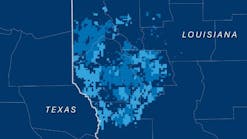XTO Energy Inc., Fort Worth, Tex., is an acquisition and development firm that decided in the late 1990s that its best chance for success was exploitation of natural gas properties, primarily in the Lower 48.
"Along about 1996, our reserves were evenly divided between oil and gas. But we decided gas was the better way to go," said Bob R. Simpson, chairman and CEO of the former Cross Timbers Oil Co., which last year changed its name to XTO Energy. "The best opportunities in the Lower 48 were in gas. A gas shortage was building, and there were none of the market vagaries of an (Organization of Petroleum Exporting Countries). We have a better profit margin from gas."
Gas weighted
XTO today is weighted 85% toward natural gas. "We've done about $1.5 billion in acquisitions since (the company's refocusing), and 95% of what we've acquired is gas," Simpson said. "We're the fourth largest independent in (total acreage) of gas reserves." From its inception in 1986 through 2001, the firm acquired reserves totaling 2.3 tcfe and added more than 1.9 tcfe—83% of the original reserves—through exploitation and development. Those reserve additions also are 88% greater than the 1.03 tcfe XTO produced during that period, Simpson said, and were done through investment of only 66% of its cash flow from operations. "That's as good a record, or better, as you will find for any company," Simpson said.
Analysts claim XTO's ability to add significant reserves through acquisitions and development at low costs in 1997-2001 was among the best of its peers. Simpson attributes the company's success to "a technology-driven effort through our staff" of 70 engineers and 20 geophysicists, with an average 20 years of experience. "That means we can put a level of power on a property that the previous owner may not have thought was worthwhile," he said.
XTO acquires long-lived properties in major US producing areas, which makes them low-risk by nature. Other common characteristics include shallow rates of decline, geologically complex reservoirs that offer opportunities for additional development, and potential upsides to increase reserves. The company works to reduce operating costs and increases production primarily though recompletions of existing wells and development drilling.
Exploration
XTO also does "a little exploration in or below existing production. That way, any wildcat we drill has a backup zone, so it's not a dry hole," said Simpson.
East Texas is the company's biggest potential growth area. XTO made its initial foray into that region in 1998 with the purchase of 251 bcfe of reserves in eight fields extending from East Texas into northwestern Louisiana. Those wells produce from the Rodessa, Travis Peak, Cotton Valley sandstone, Bossier sandstone, and Cotton Valley limestone formations at 7,000-13,000 ft. XTO's East Texas operation has more than doubled reserves since that first acquisition. It now has interests in more than 132,000 acres, plus owning related gathering facilities.
The upside of its Freestone trend discovery in East Texas is estimated at more than 2 tcfe. "We've got 100,000 net acres right on the trend," Simpson said. The company already has identified 500-700 potential well sites to be drilled. However, Simpson said, there could be as many as 2,500 sites "in theory."
Unlike many other independents, XTO has avoided foreign ventures or even operations in US waters. Neither fits its strategy of maximizing rewards while minimizing risks.
"We decided gas was the better way to go. The best opportunities in the Lower 48 were in gas."


